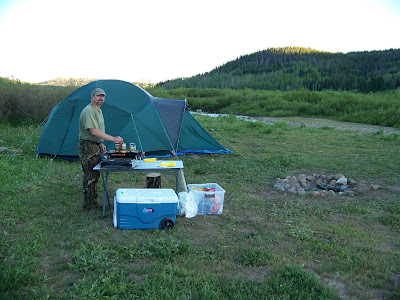Description: This is an impressive all season tent. You can tell by the rain fly that this tent
will withstand bad weather. The dome
style makes this tent sturdy and it will withstand snowfall and heavy
winds. It weighs 38 pounds with the
fiberglass poles (with aluminum it weighs 31 pounds).
It isn’t a tent that you are going to take
back packing. It is a heavy duty
tent. At the same time it is not an
overly heavy or huge canvas tent. It is
made from ripstop polyester.
The dome is
created by six poles, aluminum or fiberglass.
It has six sides. It is 6 feet 8
Inches tall and 120 square feet. It has
two doors. The main entrance door has a vestibule of approximately 5 ft by 5
ft.
The other entrance is a side/back
door which can serve as a window. It also
has a mesh side window other than the two doors.
At the top are three mesh roof vents which do
not have the option of being closed.
Since the fly goes practically to the ground there is no worry about
rain getting in, however on real cold nights you may wish these vents could be
closed. On the other hand, closing these
vents may contribute to condensation build up inside the tent. All seams are tape sealed.
The tent itself is held down with 6 stakes, one on each
corner. The stakes are made of steel, 12
inches long.
They are nice stakes;
however they bend quite easily. I have
had a few bend at the top while being pounded into the ground. The top of the stake is kind of sharp so it
marks up a plastic or rubber mallet if used.
The rainfly is huge.
It has a large vestibule in the front and goes to six inches from the
ground all around. You are going to stay
dry in this tent. In fact, I’ve had friends
ask, why do you need a tent at all when you’ve got such a robust rain fly? The rain fly uses the remainder of the approximately
22 stakes.
The fly is attached to the
bottom of the tent with little bungee cords and then attached to the ground
with 14 guy ropes and stakes. The
vestibule uses the remaining two stakes.
The tent is green and white.
The rain fly is green and gray.
There are reflector guy out loops to which the guy ropes attach.
Set up: I like the fact that the set up instructions are
sewn into the duffle bag. I have had
several other tents where the instructions were provided on paper.
These usually get lost or ruined during the
first couple uses. The instructions for
this tent will not get ruined or lost.
Floor Liner: Cabela’s
sells a real nice inside liner for this tent.
It hooks to each corner and protects the floor of the tent. It also makes cleaning easy.
Just unhook each corner, fold up the liner
and take it outside to shake off. You
can roll it up separately or put it back in the tent and roll the tent up with
it in place.
Tarp: Cabela’s also
sells a gray tarp for placing on the ground on which to pitch the tent. This tarp is pretty much worthless, similar
to the plastic from a garbage bag.
I
purchased from harbor freight a heavier duty tarp and cut it to the right shape
for the bottom of the tent and vestibule.
Vestibule: Having the
tarp big enough for the vestibule makes it so you can take your wading boots
off on the tarp under the protection of the vestibule.
The vestibule actually turns out to be quite
useful. I keep the cooler, waders to dry
and camping chairs to sit on in the spacious vestibule.
Stakes: I mentioned
the stakes earlier but I wanted to point out what I ended up doing. The stakes provided are quality, heavy duty
steel stakes. But the tops do bend after
a while, they rust and are quite heavy and bulky.
The Army Surplus stores sell the perfect
stakes. They are aluminum and therefore
lightweight, strong and they don’t rust.
They are shaped so they can stack within each other and therefore takes
little space. They are also fairly
inexpensive, 1-2 dollars apiece. There
are two different sizes and colors.
The
smaller orange ones are eight inches long.
The larger green ones are 12 inches long. Both sizes are sufficiently big and strong
enough for this tent. There is another
kind of stake also made of aluminum which is strong and won’t bend, the Coghlans
stake.
It is orange and three
sided. What I like is that it is super
light. I usually use the Army Surplus
stakes for the corners and the even lighter Coghlans stakes for the other
positions.


























